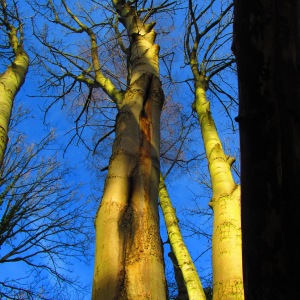Yesterday I visited the sycamore I’ve been following for the past twelve months, a last visit to scrutinize it so closely. One thing I was curious to know was how the mild winter has affected it. In early January, it should be well and truly dormant, but from what I could observe, the buds were already on the move, bursting their tightness and beginning to stretch into leaves too soon!

Bud burst… in early January!
The forecasters predict frostier weather later this week, which may well halt the urge to leaf.
A bare tree forces a tree-follower to look closer at the permanent structure, the ‘skeleton’, and I noticed things that perhaps I had seen before but not properly registered and certainly not put into words. The base of the tree is quite craggy, the bark fractured into plates typical of mature sycamores. The multi-stems are smoother, more skin-like.

Craggy bark at base of this sycamore
I also noted silvery and green blemishes which I realised were lichens. Are these newly acquired or did I just not spot them before..?

Lichens
There are dribbles and black staining I seem to have overlooked previously. It appears that two stems have merged together but not so closely that the commingled stem is watertight. This allows for moulds and slimes to take hold which may not have found opportunity otherwise, thus adding to the biodiversity of the tree as an ecosystem in its own right.

Dibbles and stains
I think the thing that surprised me the most about this tree is that it didn’t produce any flowers and thus no ‘helicopters’. For a tree species that is widely vituperated as a weed, this individual defies the profligate reproduction typical of its kind, this past year at least. I should make a note and see if it produces seed in 2016. Remind me someone, please!! The late Felix Dennis, in his collection of tree verse Tales from the Woods, wrote a poem entitled ‘Sycamore’, noting that Some rave of sycamore as if they crept/ Upon the countryside, hearts full of vice;/ Yet long before this frozen land was swept,/ All trees were interlopers of the ice. He considered it a “noble tree” and chased people off his land who sought to rip up sycamore youngsters.
On that slightly controversial note, I end my year of tree-following. For various reasons I have decided against more official tree-following in 2016, but I will continue to read with interest those accounts by others. Not forgetting to thank squirrelbasket for hosting this monthly event – cheers Pat!

Tree-following definitely encourages one to look close and carefully, as you explain so well! I like the tree-as-ecosystem idea, something new to look for.
LikeLike
Over the years, I’ve become interested in ‘veteran trees’, those that are getting on a bit and not in perfect condition. They provide unique habitats, and there is close relationship between old trees and rare species e.g. certain insects and fungi.. All extra bits’n’bobs to add to a tree-following post (especially when a tree seems to be not doing much, like my chosen tree!)
LikeLike
I don’t have this type of tree here in western NY I don’t think, but I have to look that up.. If you ever want, I have a small nature meme called Nature Notes that I post Monday night and it has been about 6 years now, but the small number of bloggers are from all over the globe and so interesting to see what is going on in Japan or Romania… You are welcome to join.. Michelle
LikeLike
Thanks for the invite. I sometimes take wildlife pictures that I can’t find a place for in a given post, so you may have just given me the excuse! Just spotted you participate in Citizen Science projects. I’ve recently got involved in something myself, but I’ll tell you all about it in an upcoming blog post..
LikeLike
Thank you for following in 2015 – sad you won’t be with us in 2016, but feel free to link in any tree posts on an occasional basis, even if you don’t choose one tree for the whole year.
I love sycamores – we used to call the seeds “whirlybirds” rather than “helicopters”, but the idea is the same!
I also seem drawn to “veteran” trees, although I am dithering in my choice for 2016 at the moment.
All the very best for 2016 and I hope you will keep on blogging on nature matters 🙂
LikeLike
No need to be sad! I might tree-follow on a quarterly basis…Didn’t realise this was ‘allowed’!
LikeLike
Pingback: Tree following link box for January 2016 | The Squirrelbasket
I think you left a comment about my sheep post… I agree, I think that most animals are so much more intelligent than we think. I plan to explore more in this area…. Michelle
LikeLike